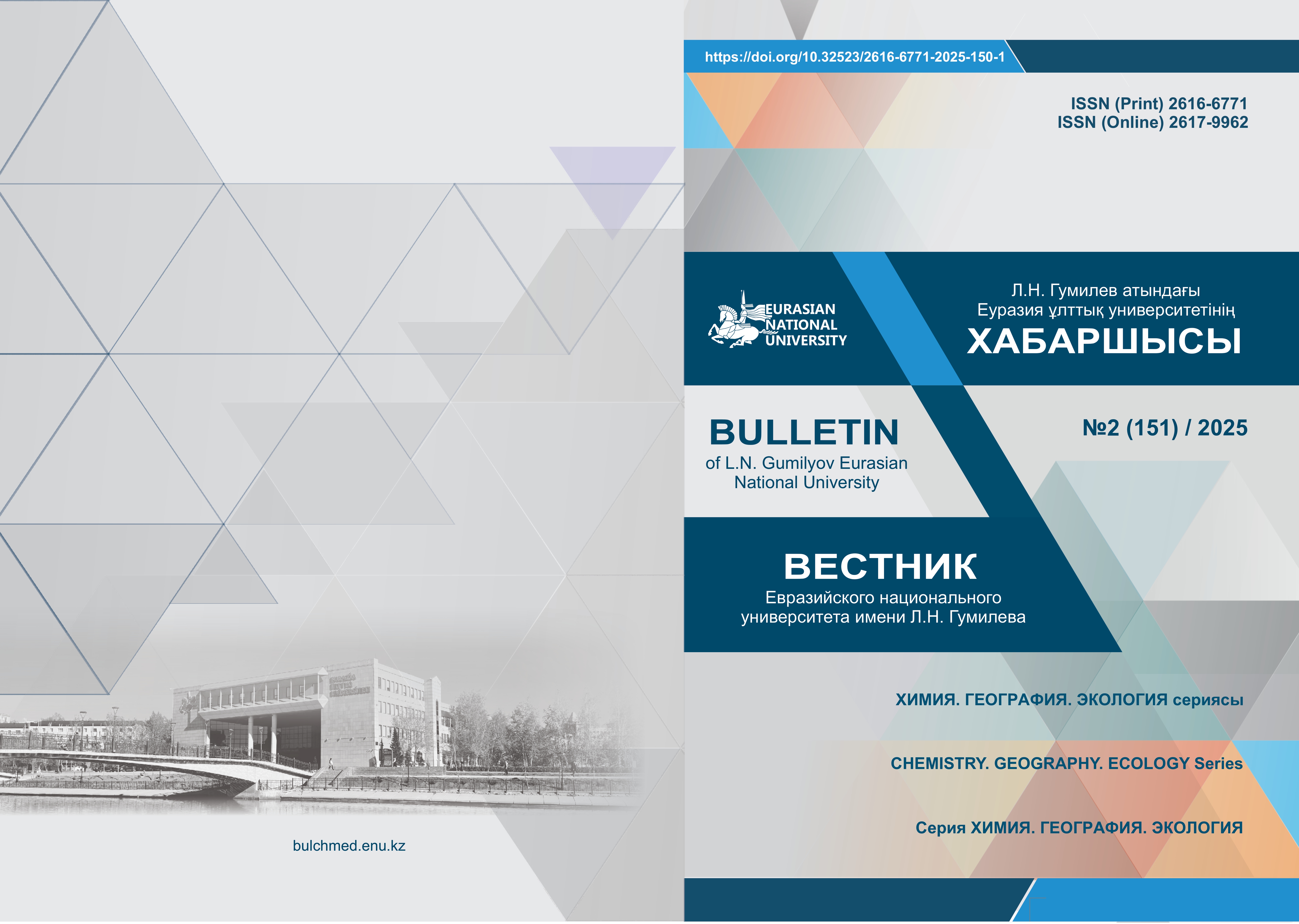Sustainable development of the Esil River Basin: an intersectoral approach and scenario analysis
Views: 447 / PDF downloads: 116
DOI:
https://doi.org/10.32523/2616-6771-2025-151-2-237-254Keywords:
sustainable development, water resources management, territorial redistribution of water resources, sustainable agriculture, small hydroAbstract
The Esil River Basin, located in northern and central Kazakhstan is a key industrial-agricultural region where agriculture dominates. The basin is characterized by high variability in annual runoff and uneven intra-annual water distribution, making water a critical factor for sustainable development. The region is facing some challenges that could potentially jeopardize its socio-economic and environmental stability, including increasing water scarcity, pollution, inefficient water management, and a growing demand, particularly from the capital city of Astana. This study presents the first integrated scenario analysis for the basin, combining inter-basin water transfer from the Irtysh River, the development of the Buzuluk Reservoir, the expansion of irrigated agriculture for high-value durum wheat, and small-scale hydropower generation. These measures are framed within an eco-engineering approach to enhance the region’s sustainability and resilience. Findings indicate that transferring up to 1.5 km3 of water annually from the Irtysh River, supported by improved storage and renewable energy generation, could significantly strengthen water, food, and energy security while contributing to Kazakhstan’s decarbonization goals. The proposed interventions demonstrate the practical application of the water-energy-food-ecosystem (WEFE) nexus and eco-engineering principles, providing policymakers with evidence-based strategies to enhance resilience against environmental and economic challenges. Future research should incorporate environmental impact assessments, socio-economic feasibility studies, and participatory approaches to ensure the effective and sustainable implementation of these strategies.
Downloads
References
Kazgiprovodkhoz Institute. (2006). The scheme of integrated use and protection of water resources of the Ishim River basin in the territory of the Republic of Kazakhstan (Skhema kompleksnogo ispol'zovaniya i ohrany vodnyh resursov bassejna reki Ishim na territorii Respubliki Kazahstan in Russian). Almaty, Kazakhstan: Kazgiprovodkhoz Institute.
Republican State Enterprise on the Right of Economic Management «Kazhydromet». (2023). State Water Cadaster of the Republic of Kazakhstan: Annual data on the regime and resources of land surface waters for 2021 (Gosudarstvennyj vodnyj kadastr Respubliki Kazahstan: Ezhegodnye dannye o rezhime i resursah poverhnostnyh vod sushi za 2021 god in Russian). Astana, Kazakhstan: Kazhydromet. https://www.kazhydromet.kz/en/gidrologiya/basseyn-reki-esil-2002-2021
Ministry of Ecology and Natural Resources of the Republic of Kazakhstan. (2021). National report on the state of the environment and on the use of natural resources of the Republic of Kazakhstan for 2020 (Nacional'nyj doklad o sostoyanii okruzhayushchej sredy i ob ispol'zovanii prirodnyh resursov Respubliki Kazahstan za 2020 god in Russian). https://www.gov.kz/memleket/entities/ecogeo/documents/details/243132?lang=ru
Bureau of National Statistics of the Agency for Strategic Planning and Reforms of the Republic of Kazakhstan. (2023). Gross harvest of agricultural crops in the Republic of Kazakhstan for 2022. https://stat.gov.kz/ru/industries/business-statistics/stat-forrest-village-hunt-fish/publications/5099/
Ali, S. M., & Acquaye, A. (2024). An examination of the water-energy-food nexus: From theory to application. Renewable and Sustainable Energy Reviews, 202, 114669. https://doi.org/10.1016/j.rser.2024.114669
Bazilian, M., Rogner, H., Howells, M., Hermann, S., Arent, D., Gielen, D., Steduto, P., Mueller, A., Komor, P., Tol, R. S. J., & Yumkella, K. K. (2011). Considering the energy, water and food nexus: Towards an integrated modelling approach. Energy Policy, 39(12), 7896-7906. https://doi.org/10.1016/j.enpol.2011.09.039
Zeng, Y., Liu, D., Guo, S., Xiong, L., Liu, P., Chen, J., Chen, H., Yin, J., Wu, Z., & Zhou, W. (2024). Assessment of the impacts of water resources allocation on the reliability, resilience and vulnerability of the water–energy–food–society (WEFS) nexus system. Agricultural Water Management, 295, 108780. https://doi.org/10.1016/j.agwat.2024.108780
Scientific Information Center of the Interstate Coordinating Water Management Commission of Central Asia. (2016). The general scheme of integrated use and protection of water resources of the Republic of Kazakhstan. Tashkent, Uzbekistan: SIC ICWC.
Amanov, O. A., & Shojmuradov, A. (2019). The effect of irrigation standards on the quality of durum wheat grain (Vliyanie norm poliva na kachestvo zerna tvyordoj pshenicy in Russian). Innovacionnaya nauka, 7-8. https://cyberleninka.ru/article/n/vliyanie-norm-poliva-na-kachestvo-zerna-tvyordoy-pshenitsy
Golubova, V., & Gaze, V. (2022). Evaluation of seed resistance of winter durum wheat varieties to lack of moisture and overheating. In XV International Scientific Conference «INTERAGROMASH 2022» (pp. 395-403). Lecture Notes in Networks and Systems (Vol. 575). Springer. https://doi.org/10.1007/978-3-031-21219-2_42
Purwanto, A., Sušnik, J., Suryadi, F.X., & de Fraiture, C. (2021). Water-energy-food nexus: Critical review, practical applications, and prospects for future research. Sustainability, 13(4), 1919. https://doi.org/10.3390/su13041919
Rivotti, P., Karatayev, M., Sobral Mourão, Z., Shah, N., Clarke, M.L., & Konadu, D.D. (2019). Impact of future energy policy on water resources in Kazakhstan. Energy Strategy Reviews, 24, 261-267. https://doi.org/10.1016/j.esr.2019.04.009
Subbotin, A. S., & Khaustov, V. A. (2012). Hydraulic engineering and land reclamation (Gidrotekhnicheskoe stroitel'stvo i melioraciya zemel' in Russian). St. Petersburg, Russia: Russian State Hydrometeorological University.
Downloads
Published
Issue
Section
License
Copyright (c) 2025 T. Dentinho, G. Saspugayeva, A. Zhaken (Author)

This work is licensed under a Creative Commons Attribution-NonCommercial 4.0 International License.








